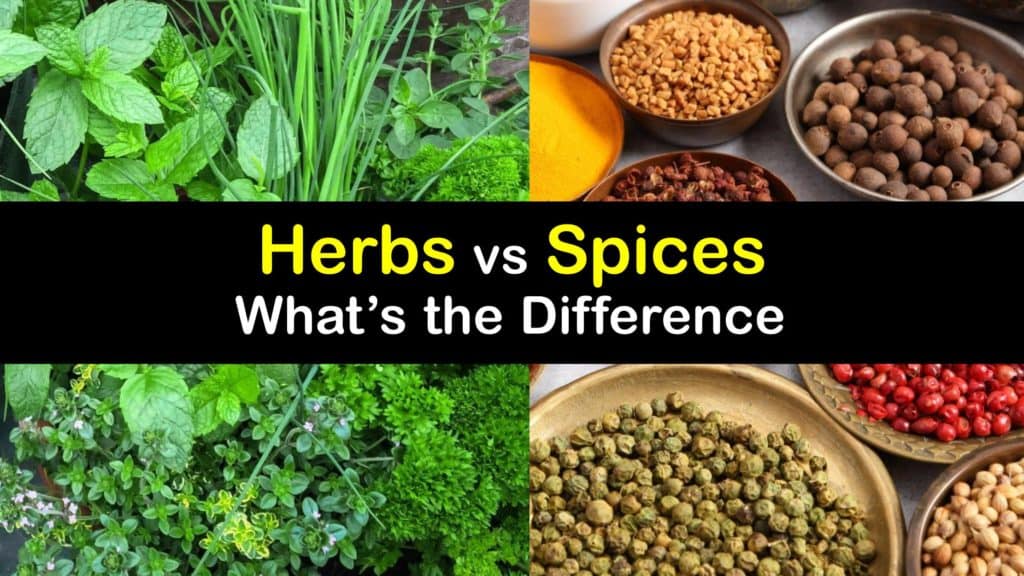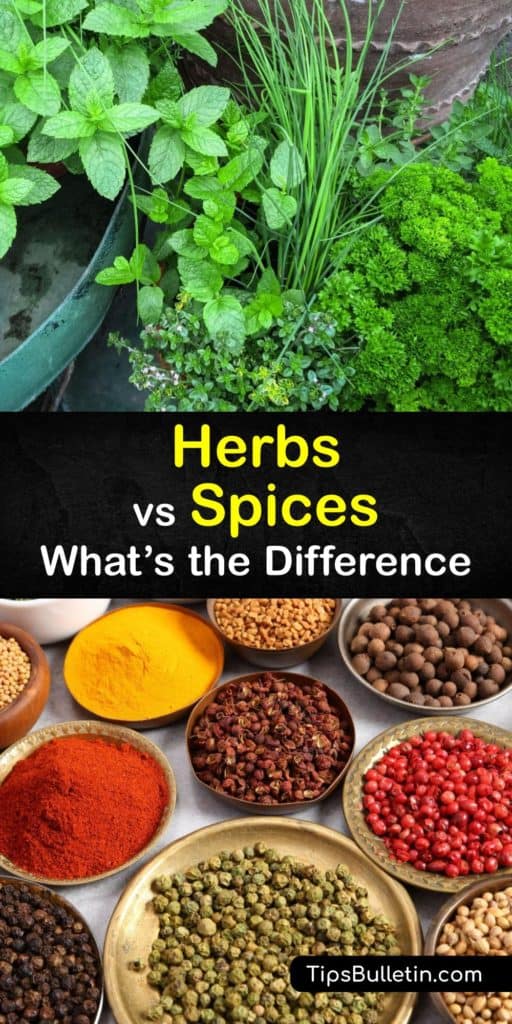Herbs and spices add flavor, texture, color, and aroma to food, and the culinary world would be pretty dull without them. While we may confuse one term for the other, there is a distinction between them. Learn the differences and similarities between herbs vs spices and tips for using them to create flavorful and fragrant dishes.
If most of your food is take-out, you’re not familiar with cooking, and someone tells you to throw some herbs and spices in a dish, you might feel a little confused. Aren’t they the same thing? While they may seem similar, there is actually a difference.
Another misconception about herbs and spices is that they have a sole purpose, and many think of culinary herbs as overpowering and spices as hot and spicy. However, this is far from the truth. While some herbs and spices are strong, others are more subtle, and they’re both beneficial to your diet.

The Differences Between Herbs and Spices
We all know they flavor food, but what is the difference between herbs and spices? They all derive from herbaceous plants, but they come from different parts of the plant at the end of the growing season, and some are fresh while others are in dried form. They range in taste and intensity depending on the type.
There is a wide range of fresh herbs, dried herbs, and ground spices, each with a distinct taste and culinary purpose. There are also many benefits to incorporating them into your diet. You may wonder about bay leaves vs basil or cilantro and coriander. Learn the difference between spices and herbs, their uses, and how to combine them to season recipes.

What is the Difference Between Herbs and Spices?
While black pepper and salt are common food seasonings, your spice cabinet probably contains a variety of herbs and spices like oregano, allspice, paprika, and cumin. What is the difference between herbs and spices?
Herbaceous plants grow in most temperate climates. Herbs come from the leafy part of plants, while spices come from the seeds, flower buds, bark, and rhizomes. An herb is the part of the plant we use for flavoring food and medicinal purposes, and we use both the fresh leaves of the plant and dried varieties. Spices are dried and crushed.
Examples of herbs are cilantro or coriander, dill weed, chives, bay leaf, marjoram, tarragon, basil, and fennel. Common spices include turmeric, cardamom, coriander seeds (Coriandrum sativum), dill seed, saffron (Crocus sativus), star anise, caraway, clove, cumin, and cinnamon (Cinnamomum verum).
It’s important to learn how to store your herbs and spices, too, so they are tasty when you need them. You don’t want to have to get rid of flour bugs in the pantry or spice cabinet.
Difference Between Spices and Herbs and Their Uses
There are so many herbs and spices that it’s often confusing knowing which ones to use for specific recipes. Discover the difference between spices and herbs for flavoring your food and benefiting your health.
There are many cooking purposes for spices and herbs. Some, such as the oil of rosemary, are natural preservatives, and others are essential for Mediterranean, Indian, and Mexican cooking. If you’re substituting fresh for dried herbs, use three to four times more than the recipe calls for and add it at the end of the cooking time.
Basil, dill, and oregano are perfect for tomato dishes, while chives, bay leaf, thyme, and cardamom seeds are ideal for soups and stews. Allspice, cinnamon, cloves, nutmeg, and ginger are excellent for baked goods, and tarragon, sage, and parsley are delicious on potatoes. Use ginger or ginseng root powder for your favorite recipes.
Many spices and herbs possess anti-inflammatory, antioxidant, and cholesterol-lowering qualities, and using them in your daily cooking provide you with many health benefits.
Cooking With Herbs vs Spices
While herbs and spices differ, combining them creates seasoning blends that change a recipe from boring to extraordinary. Here are several spice and herb combinations that are a must-have in the spice cabinet.
Combine oregano, basil, thyme, rosemary, garlic, and red pepper for the best Italian seasoning and sprinkle it over pasta, pizza, bread, and meat. There is a difference between garlic powder and granulated garlic. Garlic powder is usually better in this case.
To make blackened seasoning for Cajun cooking, mix garlic, paprika, thyme, oregano, and white, black, and cayenne peppers. Choose fresh versus dry herbs for a bit of a different flavor.
If you enjoy your meals with a little kick, combine dried hot scotch bonnet peppers, cloves, allspice, cinnamon, nutmeg, garlic, and thyme to make jerk seasoning.
A kitchen is not complete without an array of herbs and spices, and there are so many to pick from, whether you enjoy the mildness of parsley or the spiciness of chili powder. Not only do they create a symphony of flavors in your food, but they are also an excellent addition to the diet to promote good health.

We hope that learning the differences between herbs vs spices and how to use them for cooking keeps your meals aromatic and flavorful, and we’d love it if you’d share our herb and spice guide with your friends and family on Pinterest and Facebook.